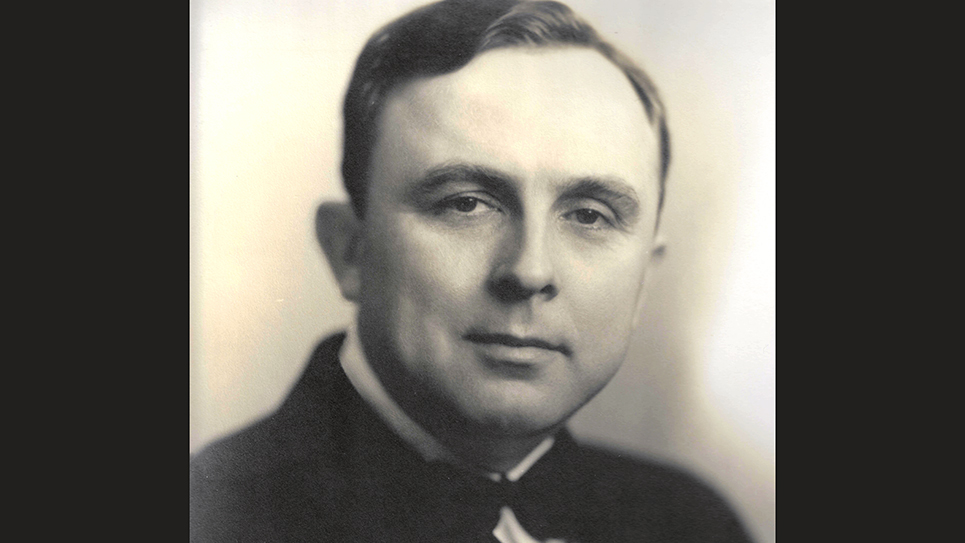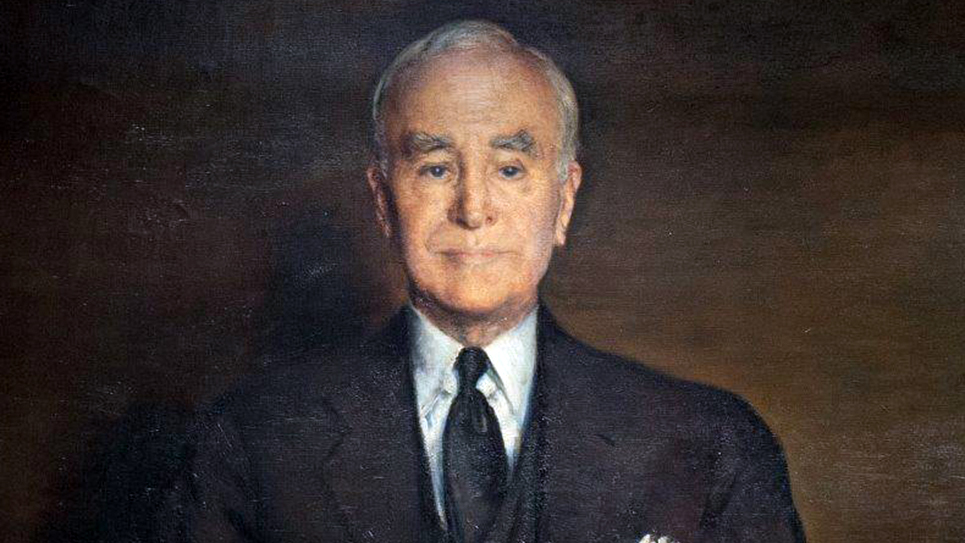Georgia’s Little New Deal: Governor Eurith D. Rivers
One of the phenomena of the coming of Franklin D. Roosevelt in 1932 was the number of states that elected governors who tried to emulate the president inasmuch as they put into place what were frequently known as “Little New Deal” administrations in their own states. Among those elected governors who worked hard to mimic FDR’s federal administration locally was Georgia’s Eurith D. Rivers.
A dapper man who always favored a black bow tie, E. D. Rivers was dignified yet well-versed in the rough and tumble that was Georgia’s politics at a time when it was a one party state. Rivers was considered Georgia’s first “modern” governor, but he was a highly controversial figure by the end of his two terms as the Peach State’s chief executive. One newspaper reporter wrote the public image of E. D. Rivers was rather like a Jekyll and Hyde existence; depending upon the view, there were two distinct sides to Rivers.
A continuous source of controversy was Governor Rivers’ habit of pardoning criminals. Many Georgians believed Ed Rivers was too generous in using his power to pardon those in jail. During the four years of his governorship, E. D. Rivers granted 1,915 pardons — 717 in one month alone. Some critics castigated the governor for having pardoned “Murderers, racketeers, lottery criminals” and the like “for pecuniary gain.”
To his critics, Rivers snapped, “I may have erred in pardoning people, but whatever error I made was on the side of mercy.”
It is often overlooked that Ed Rivers granted fewer pardons than did Eugene Talmadge in a similar 4-year period of time.
Eurith Dickinson Rivers, more commonly known as “Ed” Rivers, had held some minor political positions and moved to what was then known as Milltown, Georgia. Today the hamlet is known as Lakeland, where E. D. Rivers worked as the editor of the Lanier County News. Rivers started his political career by winning election as a Justice of the Peace at age twenty-one. Eventually, Rivers climbed the political ladder, rung by rung, first winning election to the Georgia House of Representatives and the state Senate two years later in 1926. The ambitious Rivers had his eye on the governorship and waged two unsuccessful bids for the Democratic nomination in 1928 and 1930. In 1932, Rivers opted to run once again for the Georgia House of Representatives and was promptly elected speaker of that body, a post he held for the next four years.
Rivers’ time as Speaker of the Georgia House coincided with the gubernatorial administration of Eugene Talmadge, “The Wild Man of Sugar Creek.” By 1936 there was a glaring contrast between Governor Talmadge and Speaker Rivers. Indeed, Rivers was the antithesis of Gene Talmadge in many ways. While Talmadge pretended to be a backwoodsman, Rivers made no effort to disguise his own “polished and urbane” manner. Talmadge was one of the best-known critics of the New Deal in the country and had obstructed as much of the New Deal in the state as he could; Rivers aligned himself closely with the administration of Franklin Roosevelt. At the time, Georgia governors could serve two consecutive two-year terms before having to leave office. Gene Talmadge decided to run for the United States Senate in 1936 and endorsed Charles Redwine, president of the state Senate, for governor. The 40-year-old Rivers ran again for the governorship, campaigning hard on a “Little New Deal” for the Peach State. Redwine unwisely followed Talmadge’s lead in opposing much of Roosevelt’s New Deal, which was highly popular with most Georgians. Roosevelt owned a home in Warm Springs, Georgia, where he regularly vacationed and called his second home.
Rivers campaigned as the friend of the poor. Ed Rivers widely appeared throughout the state crying, “Never again will the pots and the pans of the poor man be sold on the courthouse house steps” should he become governor. Ed Rivers won the Democratic primary with around 60% while Senator Dick Russell beat Talmadge soundly. Rivers carried 145 of Georgia’s 159 counties inside the primary. E. D. Rivers was aided in his political career by being one of Georgia’s most able orators of his time. Even his political opponents thought Rivers’ 1936 victory was due to his “tireless” efforts and “brilliant” strategy. Georgians had shown through their ballots that the New Deal was more popular than the gospel according to Gene Talmadge.
As governor, Rivers immediately asked the state legislature to ratify the various New Deal programs in Georgia that Talmadge had ignored and failed to implement. The legislature complied with Governor Rivers’ request and the New Deal came to the Peach State and her people. It was under the governorship of E. D. Rivers that electrification came to most of Georgia, especially in rural areas of the state, most of which had been without electricity before that time. During the four years of the Rivers administration, Georgia received the equivalent of $350 million in federal funding for rural electrification projects alone.
Rivers also insisted upon setting up a state bureau so citizens could claim unemployment benefits when they lost their jobs and incomes. It was Ed Rivers who provided textbooks to schoolchildren in Georgia, as well as pensions to the aged. Rivers also pushed through legislation in the legislature to provide a homestead exemption on property taxes. Like Franklin Roosevelt, E. D. Rivers was a spender. Governor Rivers also devised a means of getting around the state’s prohibition against deficit spending by convincing the legislature to create various “independent” agencies which had the authority to borrow money and sell bonds. Spending on public education in Georgia had been $29 million before Rivers became governor and four years later it was $49 million.
President Roosevelt, angry with those senators who had opposed his bid to enlarge the United States Supreme Court, sought to purge his party of political opponents, which included the senior United States senator from Georgia, the formidable Walter F. George. Roosevelt tried to entice Rivers into running for the United States Senate in 1938, but the governor preferred to seek a second term instead and turned the president down.
Most of the reforms Governor E. D. Rivers managed to effectuate occurred during the first two years of his administration. The second two years of Rivers’ term as governor were not nearly as successful as the first two years had been. The legislature would grudgingly adopt new programs pushed by Governor Rivers, but the legislators did not provide the funds necessary to properly implement those same programs. As a result, Governor Rivers had to cut state funding. Rivers, desperate for funding, tried to divert money dedicated to state highways into teachers’ salaries. Georgia’s State Highway Commissioner refused to go along, and the governor resorted to a ploy used by his predecessor, Eugene Talmadge; he used the National Guard to remove the commissioner. The actions of Governor Rivers ignited a fierce legal battle that erupted in state and federal courtrooms. Rivers was once arrested for having failed to comply with a federal court order. Eventually, Ed Rivers won the legal dispute to divert funds dedicated to highways to teachers’ salaries, but the brutal and very bitter legal warfare had taken its toll, politically and personally.
In 1941 Eurith D. Rivers, along with a few others, was indicted on charges of graft and corruption. Prosecutors charged the former governor had defrauded the State of Georgia of large sums of money. A number of trials were held, including one where Rivers was charged with having embezzled $6,000 from the state; oddly, the actual sum, at least according to prosecutors, was closer to $200,000 but the court whittled down the amount for which the former governor could be held accountable. That jury deadlocked and stayed that way. By 1943, all the remaining charges against E. D. Rivers had been dropped. A series of trials had ended in acquittals and mistrials. Rivers had dismissed the charges as little more than wild and false accusations flung by the Talmadge machine in an organized campaign of “vilification.”
And the Talmadge faction was very much alive inside Georgia. Talmadge persisted in seeking a Senate seat once again in 1938 when FDR was seeking to oust Senator Walter F. George. Yet again, voters denied Ol’ Gene a seat in the United States Senate. For those who thought Talmadge finished politically, he came roaring back in 1940 to reclaim the governorship from Eurith D. Rivers who could not run again. Two years later, a new “boy wonder” emerged in Ellis Arnall, who ran against Talmadge for the first 4-year term of office as a governor of Georgia. Gene had been up to his usual carnival sideshow political antics and lost decisively to the 36-year-old Arnall.
Forbidden by the state constitution from serving a second consecutive term in 1946, Ellis Arnall backed businessman James V. Carmichael as his successor. Eugene Talmadge was making yet another of his periodic comebacks in the 1946 Democratic primary for governor. Evidently, 50-year-old E. D. Rivers thought the time was ripe for him to return to office as well. Rivers likely believed it would be possible for him to contrast himself to the irrepressible Talmadge. Certainly, the numerous corruption trials had done nothing to enhance the image of Ed Rivers and voters had another choice aside from Gene Talmadge in the person of young businessman James V. Carmichael. Most Georgians preferred to look forward rather than go back to the past for a chief executive. Carmichael won a plurality of the ballots cast, but Georgia operated off a county-unit system, much like the Electoral College nationally, which Gene Talmadge won. Talmadge had made white supremacy the sole issue of the Democratic primary, which turned away scrutiny of his previous time in office, as well as his record. The reason Eugene Talmadge was able to make white supremacy the single most important issue of the primary campaign was due to the ruling by the U. S. Supreme Court in 1944 that Negroes were able to vote in Democratic primaries in Texas. Primus King, a Black resident of Columbus, Georgia, filed a lawsuit against the Muskogee County Democratic Committee for discrimination in denying him the right to vote. A federal district court ruled in King’s favor in a 1945 decision. That particular decision struck down the white Democratic primary in Georgia. Thought to be finished in Georgia politics after having been thoroughly beaten by Ellis Arnall, Talmadge’s native cunning and exploitation of the white supremacy issue revived his career.
It was Talmadge who became the Democratic nominee for governor while the once popular E. D. Rivers had run a poor third, winning a handful of counties and barely 10% of the votes cast. Talmadge would win the general election but die before he could assume office. In fact, many observers of the time believed it was E. D. Rivers who prevented James Carmichael from defeating Talmadge by running for governor once again by dividing the anti-Talmadge vote. The death of Eugene Talmadge incited the “three governors controversy” in Georgia, which is deserving of its own column.
E. D. Rivers was spent as a political force inside Georgia and would never again hold public office.
Rivers never made a political comeback, but rather concentrated on business. By the time he died, Rivers was a highly successful businessman and held significant media holdings including radio and television stations. Rivers began to fail and the former governor’s doctor said, “It’s not possible to say right flat-footed that any one thing took him out.” A combination of heart and kidney failure officially caused Ed Rivers’ death. “He was active up to six or eight months ago,” River’s doctor explained. “Then gradual deterioration set in. He’s been in pretty bad shape for the last three or four days. The last 24 hours he got noticeably weaker and his heart failed in the last few hours.”
© 2023 Ray Hill







